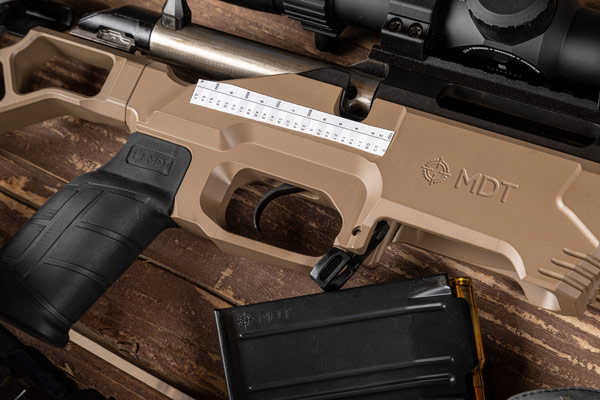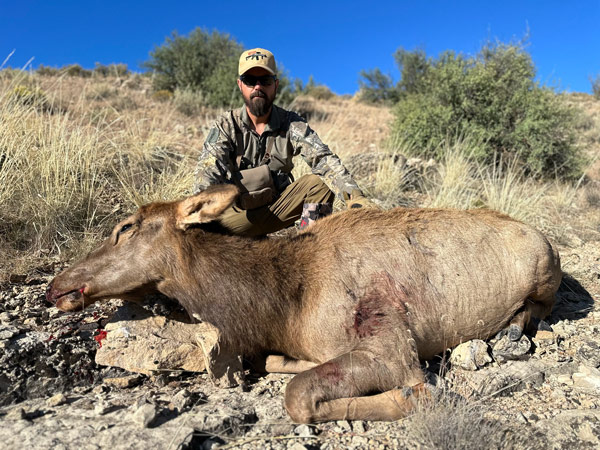Posted by Rob Orgel, Emergency Response Tactical on 2023 Nov 16th
Long-range Hunting and Shot Placement - Inside MDT
In my hunting journey across the sprawling landscapes of Western America, I've understood the crucial role of precise shot placement and the intricate dynamics of bullet energy transfer. These insights aren't just theoretical concepts but lessons deeply ingrained through my experiences and the wisdom I've gathered from observing fellow hunters.
My time serving as an infantry rifleman in Iraq and Afghanistan further solidified my understanding. I got a firsthand look at the impact of ball ammunition in rifles and machine guns, highlighting the importance of accurate shooting, even without relying on bullet expansion. My goal is to share the lessons I've learned as a hunter, Marine Rifleman, Marine Combat Instructor, and civilian Instructor rather than promote the use of specific types of ammunition, especially as regulations may vary in different regions.
More:Are You Ready for Your Hunt?
MATCH GRADE AMMUNITION AND SHOT PLACEMENT
Exploring the vast and diverse terrains of Western America, I've developed a preference for match-grade ammunition, mainly due to its consistent precision and reliability, especially when facing the challenges of long-range shooting. The Western American landscapes often demand shots at extended distances, pushing the boundaries of traditional hunting practices. My successful hunts, including deer and elk, at distances surpassing 670 yards (heart shot on a Coues deer), underscore match-grade ammunition's reliability and ethical performance, ensuring humane kills with minimal suffering.
Contrary to common belief, my experiences have emphasized that successful hunting isn't solely dependent on bullet expansion but on the precise placement of each shot. Accurate targeting remains the key to ethical and effective hunting, regardless of the ammunition used. My preference for match-grade ammunition is rooted in its dependable and predictable performance, which consistently outperforms the potential benefits of using expanding bullets.

Long-range hunting requires an accurate rifle and a deep understanding of your data.
Reflecting on my recent hunts, a particular memory stands out when a 338 Lapua Magnum shot from 370 yards took down an animal swiftly, even though the bullet passed through. Another unforgettable moment came during a challenging high-angle shot across a canyon, resulting in a successful harvest of a Western American deer at 550 yards. With my trusted 6.5 Creedmoor rifle and match-grade ammunition, I meticulously considered factors like elevation and wind speed to ensure a precise and effective shot.
Remembering a specific occasion from November 26, 2018, a well-placed shot from a 6.5 Creedmoor using match-grade ammunition precisely hit an elk's brain at 294 yards, leading to a quick and humane kill. Similarly, my experience with a 6.5 PRC rifle at 350 yards highlighted the importance of shot placement, as the match bullet remained within the elk's heart, underscoring the intricacies of understanding animal physiology. Throughout my hunts, I've noticed that the choice of ammunition might not significantly alter the outcome for hunters aiming for double lung shots. In such cases, the bullet's trajectory often creates an open cavity without causing extensive tissue damage, allowing the animal to cover a distance before succumbing to suffocation. This realization underscores the critical role of shot placement. It highlights hunters' need to deepen their understanding of animal anatomy for precise and humane kills.
My approach to hunting has evolved to prioritize precise targeting beyond general center mass shots. Understanding the exact location of vital organs has been instrumental in honing my shooting technique. Instead of settling for general shots, I've sharpened my skills to aim for specific vital points, adapting to the animal's posture and angle. This deliberate approach has significantly increased the effectiveness of my shots, ensuring that the bullet precisely hits the vital areas, increasing the likelihood of a swift and ethical takedown.

A clean kill is necessary for ethical hunting.
TERMINAL BALLISTICS AND ANATOMY
Furthermore, my extensive exploration of bullet behavior has led to a profound understanding of the unpredictable nature of bullet interactions with various barriers. Through thorough testing on live fire ranges, I've observed the erratic behavior of bullets when they come into contact with different materials, such as live tissue (off the range) and various types of glass, brush, and wood at different depths. These tests, often conducted at considerable distances exceeding hundreds of yards, have provided valuable insights into the complexities of ballistics, emphasizing the need for a nuanced understanding of how bullets interact with diverse obstacles and targets under various conditions.
Embracing this holistic approach, I've gained a deeper appreciation for the importance of understanding the anatomy of the target species. Acquiring knowledge about the precise placement of vital organs and understanding the animal's behavior and posture has allowed me to adopt a more calculated and precise approach to hunting. This refined approach not only minimizes the risk of non-lethal shots but also fosters ethical hunting practices that prioritize the welfare and swift demise of the animal.
TRAINING AND CLOSING THOUGHTS
Moreover, the significance of precise shot placement is a result of dedicated training and practice. As someone with a passion for long-range hunting, I actively engage in the range to impart my expertise to others striving to enhance their shooting abilities, especially in challenging and high-pressure situations. Guided by my commitment to excellence, I hold myself to the highest standards, continually refining my marksmanship skills and passing on these principles to my peers. This relentless pursuit of proficiency has enhanced my understanding of the intricacies of shooting in demanding environments and equipped me with the knowledge to emphasize the criticality of precision and accuracy in every shot taken. In the vast and diverse landscapes of Western America, responsible and respectful engagement with wildlife is crucial to upholding the principles of ethical hunting. By cultivating a deeper understanding of animal anatomy and behavior, hunters can ensure that each shot is accurate, minimizing potential suffering and honoring the dignity of the hunt and the natural world.
HUNTING RESOURCES FROM MDT
- Hunting Drills for Success
- Necessities for a Backcountry Hunt
- MeatEater: Dialing in your Kit for 2023
- Staying Mentally Strong in the Backcountry
- Fitness for Backcountry Hunting
- How Shooting Matches Makes You a Better Hunter
- Tips For A Successful Antelope Hunt
- Analysis: Long-Range Hunting
- Why The Triple Pull CKYE-POD is a Guides Best Friend
- Hunting In Inclement Weather
- Maximize Performance with Mental Imagery
- Sheep Hunting in Kyrgyzstan
- Are You Ready for Your Hunt?
- The Ethical Shot
- The Modern Hunting Vest
- Tag Your Hunting Truck
- How To Hunt Stone Sheep In British Columbia
ABOUT THE AUTHOR
Rob Orgel enlisted in the USMC in 2004 as an Infantry Rifleman (0311), serving with 3rd Bn 1st Marines in Iraq, including roles as a point man in OIF-3 & team leader in OIF-6. Later, he joined the 1st Marine Regiment, achieved the rank of Sergeant in 2010, & continued service in Afghanistan. Upon returning, he became a Combat Instructor at the School Of Infantry West. Transitioning to private military contracting with Securing Our Country (SOC), he instructed at the American Embassy in Iraq. In 2018, Rob became Chief Instructor at GPS Defense Sniper School, revamping their program. Now, as owner & lead instructor at Emergency Response Tactical, he focuses on training novice to advanced shooters on the range over 300 days a year.


 CAD
CAD
 Euro
Euro
